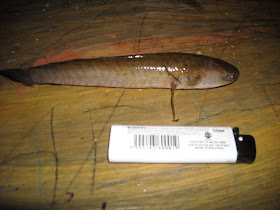


IKAN HARUAN
Ikan haruan atau nama saintifiknya Channa striatus merupakan spesis ikan air tawar karnivor dan popular di negara ini.
Populariti ikan haruan bukan sahaja sebagai sajian makanan atau sumber protein semata-mata tetapi menjangkau sehingga kepada penggunaan dalam perubatan.
Di kalangan masyarakat Melayu, ikan haruan digunakan dalam perubatan tradisional iaitu untuk rawatan dalaman terutama ibu yang baru lepas bersalin.
Hal yang sama juga berlaku bagi masyarakat Cina dan India dan masyarakat lain yang juga terkenal dengan penggunaan ikan haruan sebagai rawatan tradisional.
Para penyelidik telah menemui sesuatu yang menarik dalam ikan haruan iaitu terdapat 17 jenis asid amino dalam ikan haruan antaranya glycine, alanine, praline, isoleucine, leucine, methanine dan throenine yang secara realitifnya lebih tinggi dalam spesis berkenaan berbanding yang lain.
Selain protein itu, ikan haruan juga mengandungi lemak dan kedua-dua merupakan komponen biokimia penting dalam proses penyembuhan luka.
Ekologi:
Terdapat 30 spesis dalam famili Channidae dan lapan daripadanya terdapat di negara ini termasuk haruan Channa striatus, Toman Channa micropeltes dan Bujuk Channa lucius. Haruan biasanya hidup dalam air cetak sedalam kira-kira satu meter. keruh dan tenang pada suhu 20 dan 30 darjah Celsius. Dengan sifat karnivor, haruan makan haiwan kecil termasuk ikan, reptilia dan amfibia.
Kelakuan/Tabiat:
Spesis ini mempunyai tabiat berenang ke air bersih dan mencari makanan di kawasan yang banyak makanan. Ketika musim kemarau ikan tersebut menyorok dalam lumpur dan keluar semula apabila keadaan kembali normal.
Reproduksi:
Secara semulajadi haruan membiak beberapa minggu sebelum musin hujan dan anak-anak ikan membesar kepada saiz dewasa bagi menghadapi musim banjir. Ini menjadi satu strategi bagi mengelakkan pemangsa seperti ular, burung dan sebagainya.
Penternakan:
Haruan membiak sama ada secara semulajadi atau juga di ladang ternakan termasuk teknik aruhan. Ikan ini mampu membiak sehingga 1,000 ekor anak ikan dan dalam kolam konkrit dengan kedalaman tiga kaki dan stok antara 2,000 dan 3,000 ekor bergantung kepada saiz kolam. Ia memerlukan empat bulan untuk membesar mencapai saiz pasaran seberat 250gm.
(Sumber Utusan Malaysia)
